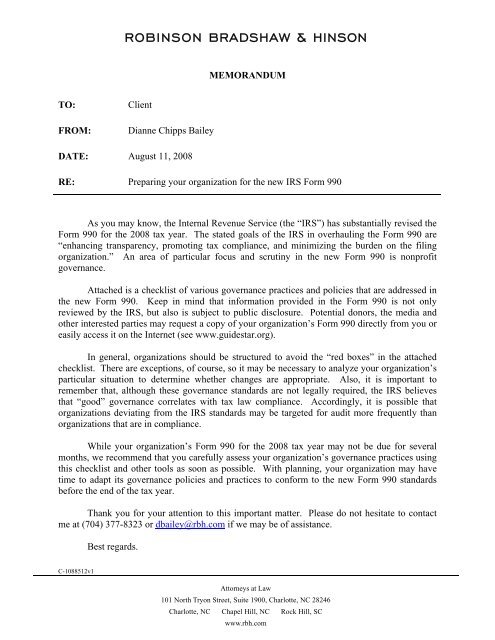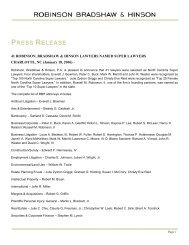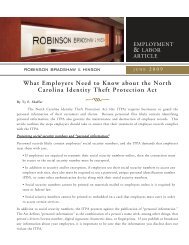New IRS Form 990 - Robinson, Bradshaw and Hinson
New IRS Form 990 - Robinson, Bradshaw and Hinson
New IRS Form 990 - Robinson, Bradshaw and Hinson
Create successful ePaper yourself
Turn your PDF publications into a flip-book with our unique Google optimized e-Paper software.
ROBINSON BRADSHAW & HINSON<br />
MEMORANDUM<br />
TO:<br />
FROM:<br />
Client<br />
Dianne Chipps Bailey<br />
DATE: August 11, 2008<br />
RE: Preparing your organization for the new <strong>IRS</strong> <strong>Form</strong> <strong>990</strong><br />
As you may know, the Internal Revenue Service (the “<strong>IRS</strong>”) has substantially revised the<br />
<strong>Form</strong> <strong>990</strong> for the 2008 tax year. The stated goals of the <strong>IRS</strong> in overhauling the <strong>Form</strong> <strong>990</strong> are<br />
“enhancing transparency, promoting tax compliance, <strong>and</strong> minimizing the burden on the filing<br />
organization.” An area of particular focus <strong>and</strong> scrutiny in the new <strong>Form</strong> <strong>990</strong> is nonprofit<br />
governance.<br />
Attached is a checklist of various governance practices <strong>and</strong> policies that are addressed in<br />
the new <strong>Form</strong> <strong>990</strong>. Keep in mind that information provided in the <strong>Form</strong> <strong>990</strong> is not only<br />
reviewed by the <strong>IRS</strong>, but also is subject to public disclosure. Potential donors, the media <strong>and</strong><br />
other interested parties may request a copy of your organization’s <strong>Form</strong> <strong>990</strong> directly from you or<br />
easily access it on the Internet (see www.guidestar.org).<br />
In general, organizations should be structured to avoid the “red boxes” in the attached<br />
checklist. There are exceptions, of course, so it may be necessary to analyze your organization’s<br />
particular situation to determine whether changes are appropriate. Also, it is important to<br />
remember that, although these governance st<strong>and</strong>ards are not legally required, the <strong>IRS</strong> believes<br />
that “good” governance correlates with tax law compliance. Accordingly, it is possible that<br />
organizations deviating from the <strong>IRS</strong> st<strong>and</strong>ards may be targeted for audit more frequently than<br />
organizations that are in compliance.<br />
While your organization’s <strong>Form</strong> <strong>990</strong> for the 2008 tax year may not be due for several<br />
months, we recommend that you carefully assess your organization’s governance practices using<br />
this checklist <strong>and</strong> other tools as soon as possible. With planning, your organization may have<br />
time to adapt its governance policies <strong>and</strong> practices to conform to the new <strong>Form</strong> <strong>990</strong> st<strong>and</strong>ards<br />
before the end of the tax year.<br />
Thank you for your attention to this important matter. Please do not hesitate to contact<br />
me at (704) 377-8323 or dbailey@rbh.com if we may be of assistance.<br />
Best regards.<br />
C-1088512v1<br />
Attorneys at Law<br />
101 North Tryon Street, Suite 1900, Charlotte, NC 28246<br />
Charlotte, NC Chapel Hill, NC Rock Hill, SC<br />
www.rbh.com
ROBINSON BRADSHAW & HINSON<br />
Governance Compliance Checklist for the <strong>New</strong> <strong>IRS</strong> <strong>Form</strong> <strong>990</strong><br />
Section A. Governing Body <strong>and</strong> Management<br />
1. Are any voting members of the governing board not independent? Yes No<br />
• Independent means that no staff members serve as voting members <strong>and</strong><br />
that all voting members serve as uncompensated volunteers.<br />
2. Did any officer, director, trustee, or key employee have a family<br />
relationship or a business relationship with any other officer,<br />
director, trustee, or key employee? Yes No<br />
3. Did the organization delegate control over management duties<br />
customarily performed by or under the direct supervision of officers,<br />
directors or trustees, or key employees to a management company<br />
or other person? Yes No<br />
4. Did the organization contemporaneously document the meetings<br />
held or written actions undertaken during the year by the following:<br />
a. the governing body? Yes No<br />
b. each committee with authority to act on behalf of the governing<br />
body? Yes No<br />
5 a. Does the organization have local chapters, branches, or affiliates? Yes No<br />
b. If “Yes,” does the organization have written policies <strong>and</strong><br />
procedures governing the activities of such chapters, affiliates, <strong>and</strong><br />
branches to ensure their operations are consistent with those of the<br />
organization? Yes No<br />
6. Was a copy of the <strong>Form</strong> <strong>990</strong> provided to the organization’s<br />
governing body before it was filed? Yes No<br />
• State “Yes” only if a copy of the organization’s final <strong>Form</strong> <strong>990</strong> (including<br />
required schedules), as ultimately filed with the <strong>IRS</strong>, was provided to each<br />
voting member of the organization’s governing body, whether in paper or<br />
electronic form, before or after its filing with the <strong>IRS</strong>.<br />
C-1086612v1<br />
Attorneys at Law<br />
101 North Tryon Street, Suite 1900, Charlotte, NC 28246<br />
Charlotte, NC Chapel Hill, NC Rock Hill, SC<br />
www.rbh.com
• In the space below, describe the process, if any, by which any of the<br />
organization’s officers directors, trustees, board committee members, or<br />
management reviewed the prepared <strong>Form</strong> <strong>990</strong>, whether before it<br />
was filed with the <strong>IRS</strong>.<br />
Section B. Policies<br />
7 a. Does the organization have a written conflict of interest policy? Yes No<br />
• A conflict of interest policy:<br />
o Defines conflicts of interest as:<br />
• A “conflict of interest” arises when a person in a position<br />
of authority over an organization, such as an officer,<br />
director, or manager, may benefit financially from a decision<br />
he or she could make in such capacity, including indirect<br />
benefits such as to family members or businesses with<br />
which the person is closely associated.<br />
o Identifies the classes of individuals within the organization covered<br />
by the policy<br />
o Facilitates advance disclosure of information that may help identify conflicts<br />
of interest<br />
o Specifies procedures to be followed in managing conflicts of interest<br />
If “Yes”:<br />
b. Are officers, directors or trustees, <strong>and</strong> key employees required to<br />
disclose annually interests that could give rise to conflicts? Yes No<br />
c. Does the organization regularly <strong>and</strong> consistently monitor <strong>and</strong><br />
enforce compliance with the policy? Yes No<br />
If “Yes,” describe below how this is done.<br />
8. Does the organization have a written whistleblower policy? Yes No<br />
• A whistleblower policy:<br />
o Encourages staff <strong>and</strong> volunteers to come forward with credible<br />
information related to illegal practices or violations of adopted policies of<br />
the organization;<br />
o Specifies that the organization will protect the disclosing individual from<br />
retaliation; <strong>and</strong><br />
o Identifies those staff or board members or outside parties to whom<br />
such information can be reported.<br />
C-1086612v1<br />
2
9. Does the organization have a written document retention <strong>and</strong><br />
destruction policy? Yes No<br />
• A document retention <strong>and</strong> destruction policy:<br />
o Identifies the record retention responsibilities of the staff, volunteers,<br />
board members, <strong>and</strong> outsiders for maintaining <strong>and</strong> documenting the<br />
storage <strong>and</strong> destruction of the organization’s documents <strong>and</strong> records.<br />
10. Did the process for determining compensation of the following<br />
persons include a review <strong>and</strong> approval by independent persons,<br />
comparability data, <strong>and</strong> contemporaneous substantiation of the<br />
deliberation <strong>and</strong> decision:<br />
a. The organization’s CEO, Executive Director, or top management<br />
official? Yes No<br />
b. Other officers or key employees of the organization? Yes No<br />
11. Did the organization invest in, contribute assets to, or participate in<br />
a joint venture or similar arrangement with a taxable for-profit entity during<br />
the year? Yes No<br />
Section C. Disclosure<br />
12. IRC Section 6104 requires an organization to make its <strong>Form</strong> 1023<br />
(or 1024 if applicable), <strong>990</strong>, <strong>and</strong> <strong>990</strong>-T (501(c)(3)s only) available for<br />
public inspection. Indicate how you make these available.<br />
Check all that apply.<br />
Own website Another’s website Upon request<br />
None of the above<br />
13. Does the organization make its governing documents, conflict of interest<br />
policy, <strong>and</strong> financial statements available to the public?<br />
Yes<br />
No<br />
C-1086612v1<br />
3





